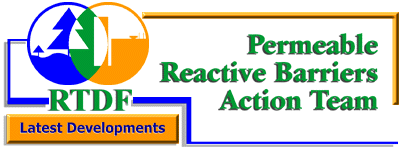 |
|
||||||
|
|
|
||||||
|
|
|||||||
 |
|
||||||
|
|
|
||||||
|
|
|||||||
|
Contaminants: Reactive Media: Cost: Construction: Point of Contact: |
|
|
A full-scale permeable reactive barrier (PRB) was installed at a former dry-cleaning site in an urban area in Rheine, Westphalia in Germany. The mandrel construction method was chosen because it was determined to be easier and less expensive than continuous sheet piling construction. Perchloroetylene (PCE) and 1,2-dichloroethylene (1,2-DCE) are the primary contaminants of concern at the site. Initial maximum concentrations in the plume were 20,000 µg/L for PCE and 500 µg/L for 1,2-DCE. The plume is 1,640-ft-long and 820-ft-wide. The distance from the center of contamination to the treatment wall is about 1,300 ft. The plume is present in a loamy sand aquifer that extends 16-33 ft below grade. The water table is about 10 ft below the ground surface. The hydraulic conductivity varies between about 0.3 and 2.8 ft/day. The PRB is a continuous reactive wall that varies between 2 and 3 ft wide and is 74 ft long. The PRB was constructed by drilling a line of overlapping 3-ft diameter boreholes which were filled with reactive material to ground-water level, and with clean soil to ground surface level. The PRB uses two reactive media: 69 tons of granular zero-valent iron mixed with gravel at a 1:2 volume ratio (34.5 tons each of zero-valent iron and gravel) in 33 ft of the wall and 85 tons of iron sponge in 41 ft of the wall. A concrete-filled borehole separates the two segments. (Iron sponge consists of wood shavings or wood chips impregnated with hydrated iron oxide. It is used for removal of hydrogen sulfide in oil and gas processing operations.) This is the first continuous treatment wall in Germany and was built as a research project with no specific target cleanup concentrations. However, the PRB has resulted in significant reduction in the concentration of contaminants—especially PCE. The effluent concentration of PCE from the granular iron section of the wall is 33 µg/L (from 17,000 µg/L in the affluent) and 400 µg/L from the iron sponge section of the wall (from 14,500 µg/L in the affluent). There has been only a low level of metabolite production. No vinyl chloride was observed in the affluent or effluent of the PRB. There was measurable production of hydrogen only at the very beginning of the remediation process—simultaneous with a complete reduction of nitrogen to ammonia. Ground-water samples are being collected monthly. |
![]()
Sponsored by the Technology Innovation Program
Date Last Modified: January 14, 2000